reset CADILLAC CTS 2006 1.G Owners Manual
[x] Cancel search | Manufacturer: CADILLAC, Model Year: 2006, Model line: CTS, Model: CADILLAC CTS 2006 1.GPages: 442, PDF Size: 2.57 MB
Page 85 of 442

Central Door Unlocking System
Your vehicle has a central door unlocking feature.
When unlocking the driver’s door, you can unlock the
other doors by holding the key in the turned position
for a few seconds or by quickly turning the key twice
in the lock cylinder.
Power Door Locks
The power door lock
switches are located on
the front doors.
Press the bottom part of the power door lock switch to
lock or the top of the switch to unlock all the doors
at once.
The rear doors do not have power door lock switches.
You must use the manual levers to lock and unlock
the rear doors when riding in the rear seat.
Delayed Locking
With this feature, you can delay the actual locking of
the doors.
When the power door lock switch or the lock button on
the Remote Keyless Entry (RKE) transmitter is
pressed when the key is not in the ignition and the
driver’s door is opened, a chime will sound three times
indicating that delayed locking is active.
When all the doors are closed, the doors will lock
automatically after �ve seconds. If a door is reopened
before �ve seconds have elapsed, the �ve second timer
will reset itself once all the doors are closed again.
You can press the door lock switch or the lock button
on the RKE transmitter again to override this feature and
lock the doors immediately.
You can turn this feature off using the Driver Information
Center (DIC). When delayed locking is off, the doors
will lock immediately when you press the power
door lock switch or the lock button on the RKE
transmitter. SeeDIC Vehicle Personalization on
page 3-70for more information.
2-9
Page 92 of 442
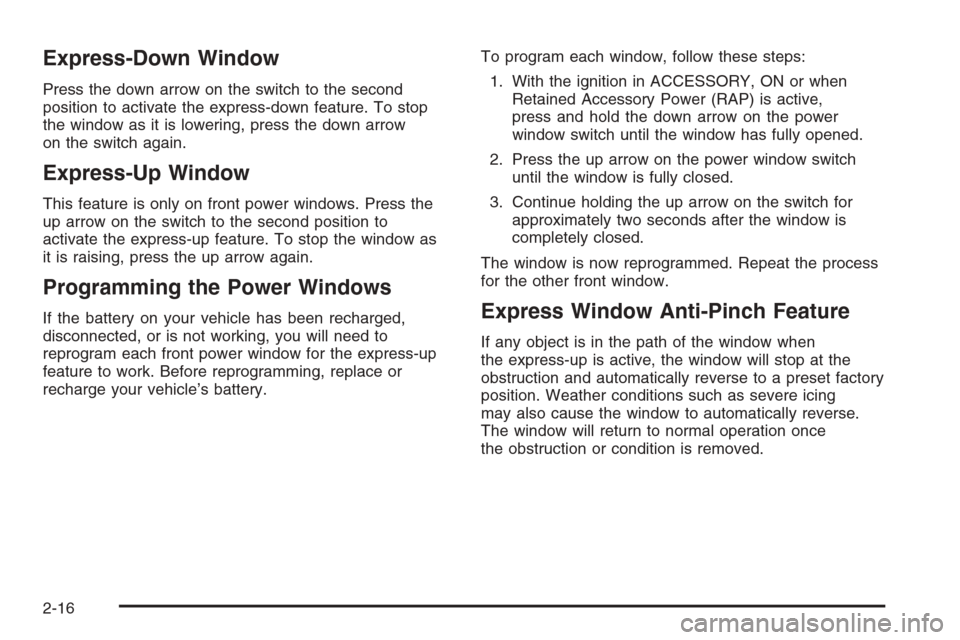
Express-Down Window
Press the down arrow on the switch to the second
position to activate the express-down feature. To stop
the window as it is lowering, press the down arrow
on the switch again.
Express-Up Window
This feature is only on front power windows. Press the
up arrow on the switch to the second position to
activate the express-up feature. To stop the window as
it is raising, press the up arrow again.
Programming the Power Windows
If the battery on your vehicle has been recharged,
disconnected, or is not working, you will need to
reprogram each front power window for the express-up
feature to work. Before reprogramming, replace or
recharge your vehicle’s battery.To program each window, follow these steps:
1. With the ignition in ACCESSORY, ON or when
Retained Accessory Power (RAP) is active,
press and hold the down arrow on the power
window switch until the window has fully opened.
2. Press the up arrow on the power window switch
until the window is fully closed.
3. Continue holding the up arrow on the switch for
approximately two seconds after the window is
completely closed.
The window is now reprogrammed. Repeat the process
for the other front window.Express Window Anti-Pinch Feature
If any object is in the path of the window when
the express-up is active, the window will stop at the
obstruction and automatically reverse to a preset factory
position. Weather conditions such as severe icing
may also cause the window to automatically reverse.
The window will return to normal operation once
the obstruction or condition is removed.
2-16
Page 116 of 442

Mirror Operation
The automatic dimming feature comes on each time the
vehicle is started.
To turn the automatic dimming feature on or off, press
the on/off button. The indicator light will illuminate
when this feature is on.
Compass Operation
Press the on/off button once to turn the compass on
or off.
When the ignition and the compass feature are on, the
compass will show two character boxes for
approximately two seconds. After two seconds, the
mirror will display the current compass direction.
Compass Calibration
If after two seconds the display does not show a
compass direction, (N for North for example), there may
be a strong magnetic �eld interfering with the compass.
Such interference may be caused by a magnetic
antenna mount, note pad holder, or similar object. If the
letter C appears in the compass window, the compass
may need to be reset or calibrated.The mirror can be calibrated by driving the vehicle in
circles at 5 mph (8 km/h) or less until the display reads
a direction.
The compass can be calibrated by pressing and holding
the on/off button until a C is shown in the compass
display.
Compass Variance
Compass variance is the difference between earth’s
magnetic north and true geographic north. If the mirror
is not adjusted for compass variance, the compass
could give false readings.
The mirror is set in zone eight upon leaving the factory.
It will be necessary to adjust the compass to
compensate for compass variance if the vehicle is
driven outside zone eight. Under certain circumstances,
such as a long distance, cross-country trip, it will be
necessary to adjust the compass variance.
2-40
Page 144 of 442
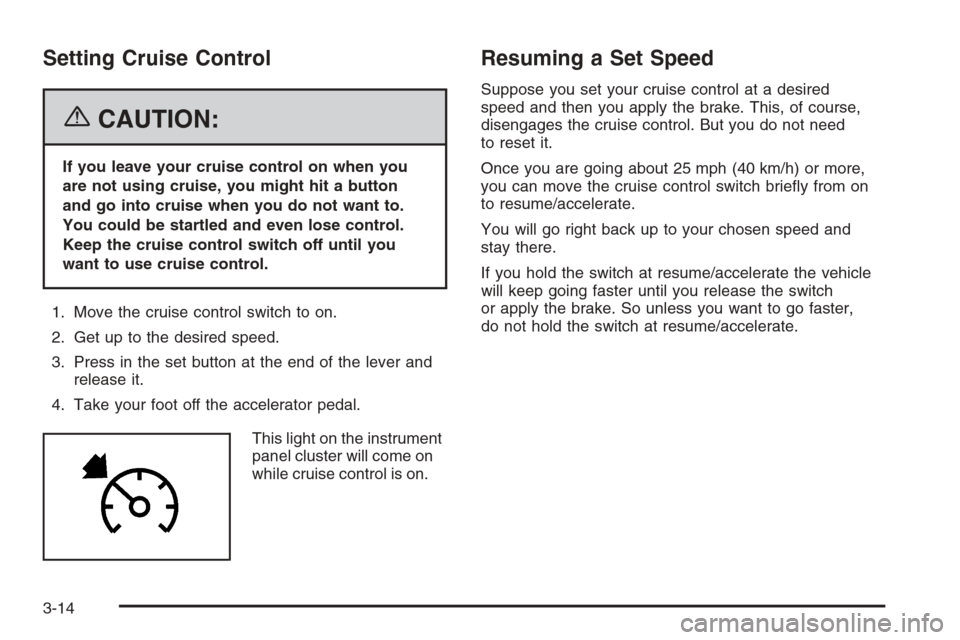
Setting Cruise Control
{CAUTION:
If you leave your cruise control on when you
are not using cruise, you might hit a button
and go into cruise when you do not want to.
You could be startled and even lose control.
Keep the cruise control switch off until you
want to use cruise control.
1. Move the cruise control switch to on.
2. Get up to the desired speed.
3. Press in the set button at the end of the lever and
release it.
4. Take your foot off the accelerator pedal.
This light on the instrument
panel cluster will come on
while cruise control is on.
Resuming a Set Speed
Suppose you set your cruise control at a desired
speed and then you apply the brake. This, of course,
disengages the cruise control. But you do not need
to reset it.
Once you are going about 25 mph (40 km/h) or more,
you can move the cruise control switch brie�y from on
to resume/accelerate.
You will go right back up to your chosen speed and
stay there.
If you hold the switch at resume/accelerate the vehicle
will keep going faster until you release the switch
or apply the brake. So unless you want to go faster,
do not hold the switch at resume/accelerate.
3-14
Page 145 of 442
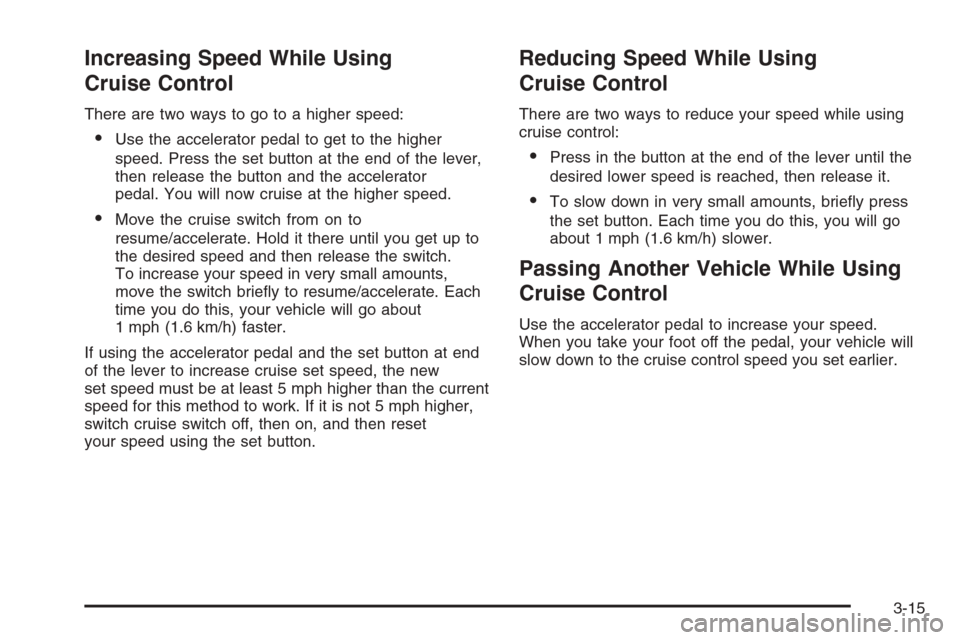
Increasing Speed While Using
Cruise Control
There are two ways to go to a higher speed:
Use the accelerator pedal to get to the higher
speed. Press the set button at the end of the lever,
then release the button and the accelerator
pedal. You will now cruise at the higher speed.
Move the cruise switch from on to
resume/accelerate. Hold it there until you get up to
the desired speed and then release the switch.
To increase your speed in very small amounts,
move the switch brie�y to resume/accelerate. Each
time you do this, your vehicle will go about
1 mph (1.6 km/h) faster.
If using the accelerator pedal and the set button at end
of the lever to increase cruise set speed, the new
set speed must be at least 5 mph higher than the current
speed for this method to work. If it is not 5 mph higher,
switch cruise switch off, then on, and then reset
your speed using the set button.
Reducing Speed While Using
Cruise Control
There are two ways to reduce your speed while using
cruise control:
Press in the button at the end of the lever until the
desired lower speed is reached, then release it.
To slow down in very small amounts, brie�y press
the set button. Each time you do this, you will go
about 1 mph (1.6 km/h) slower.
Passing Another Vehicle While Using
Cruise Control
Use the accelerator pedal to increase your speed.
When you take your foot off the pedal, your vehicle will
slow down to the cruise control speed you set earlier.
3-15
Page 169 of 442
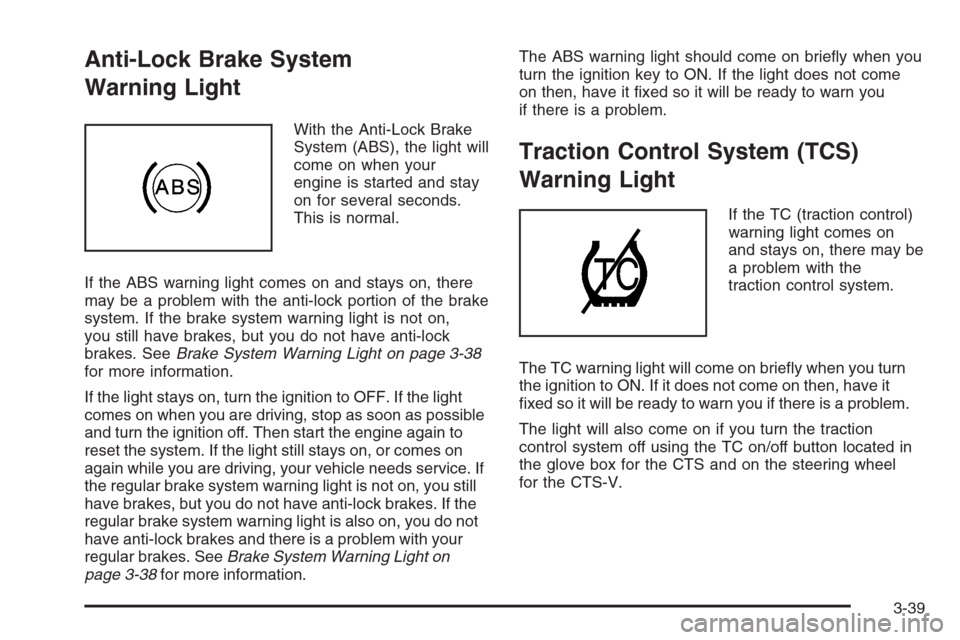
Anti-Lock Brake System
Warning Light
With the Anti-Lock Brake
System (ABS), the light will
come on when your
engine is started and stay
on for several seconds.
This is normal.
If the ABS warning light comes on and stays on, there
may be a problem with the anti-lock portion of the brake
system. If the brake system warning light is not on,
you still have brakes, but you do not have anti-lock
brakes. SeeBrake System Warning Light on page 3-38
for more information.
If the light stays on, turn the ignition to OFF. If the light
comes on when you are driving, stop as soon as possible
and turn the ignition off. Then start the engine again to
reset the system. If the light still stays on, or comes on
again while you are driving, your vehicle needs service. If
the regular brake system warning light is not on, you still
have brakes, but you do not have anti-lock brakes. If the
regular brake system warning light is also on, you do not
have anti-lock brakes and there is a problem with your
regular brakes. SeeBrake System Warning Light on
page 3-38for more information.The ABS warning light should come on brie�y when you
turn the ignition key to ON. If the light does not come
on then, have it �xed so it will be ready to warn you
if there is a problem.
Traction Control System (TCS)
Warning Light
If the TC (traction control)
warning light comes on
and stays on, there may be
a problem with the
traction control system.
The TC warning light will come on brie�y when you turn
the ignition to ON. If it does not come on then, have it
�xed so it will be ready to warn you if there is a problem.
The light will also come on if you turn the traction
control system off using the TC on/off button located in
the glove box for the CTS and on the steering wheel
for the CTS-V.
3-39
Page 170 of 442

If the TC warning light stays on or comes on while you
are driving, pull off the road as soon as possible
and stop carefully. Try resetting the system by turning
the ignition off then back on. If the light still stays
on or comes back on again while you are driving, your
vehicle needs service. Have the Traction Control
System (TCS) inspected as soon as possible. See
Traction Control System (TCS) (CTS) on page 4-9or
Traction Control System (TCS) (CTS-V) on page 4-10
for more information.
Engine Coolant Temperature
Warning Light (CTS)
This light will come on
when you �rst start the
vehicle as a check
to let you know that the
light is working.
It will go out after a few seconds. If the light does not
come on, see your dealer.If the light does not go out or if the light comes on and
stays on while you are driving, your vehicle may
have a problem with the cooling system. You should
stop the vehicle and turn off the engine as soon
as possible to avoid damage to the engine. A warning
chime will also sound when this light is on.
SeeEngine Overheating on page 5-28for more
information.
Engine Coolant Temperature Gage
This gage shows the
engine coolant
temperature. If the gage
pointer moves into
the shaded area, the
engine is too hot.
That reading means the same thing as the warning
light – the engine coolant is very hot. SeeEngine
Overheating on page 5-28.
3-40
Page 179 of 442
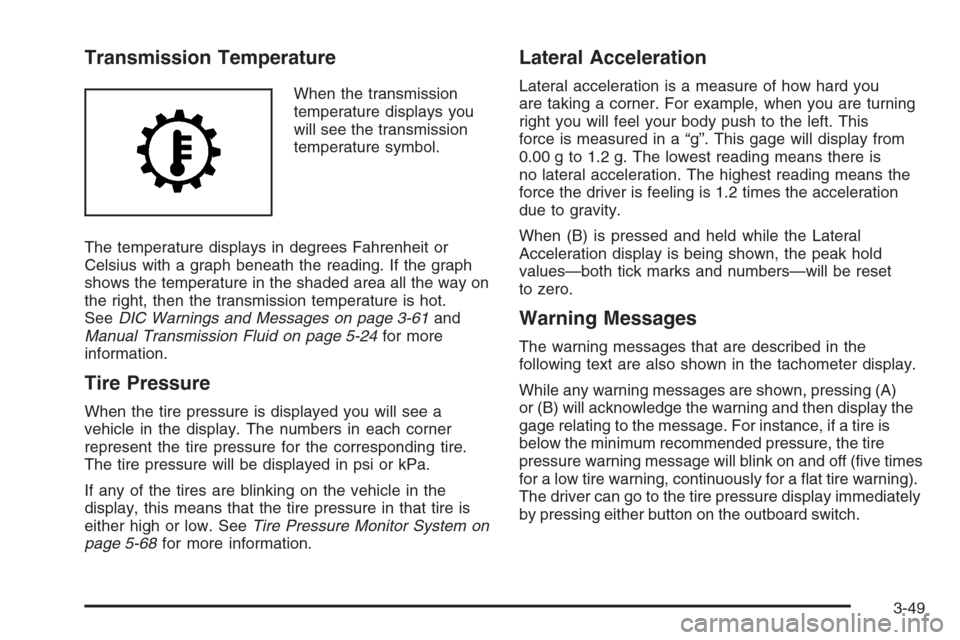
Transmission Temperature
When the transmission
temperature displays you
will see the transmission
temperature symbol.
The temperature displays in degrees Fahrenheit or
Celsius with a graph beneath the reading. If the graph
shows the temperature in the shaded area all the way on
the right, then the transmission temperature is hot.
SeeDIC Warnings and Messages on page 3-61and
Manual Transmission Fluid on page 5-24for more
information.
Tire Pressure
When the tire pressure is displayed you will see a
vehicle in the display. The numbers in each corner
represent the tire pressure for the corresponding tire.
The tire pressure will be displayed in psi or kPa.
If any of the tires are blinking on the vehicle in the
display, this means that the tire pressure in that tire is
either high or low. SeeTire Pressure Monitor System on
page 5-68for more information.
Lateral Acceleration
Lateral acceleration is a measure of how hard you
are taking a corner. For example, when you are turning
right you will feel your body push to the left. This
force is measured in a “g”. This gage will display from
0.00 g to 1.2 g. The lowest reading means there is
no lateral acceleration. The highest reading means the
force the driver is feeling is 1.2 times the acceleration
due to gravity.
When (B) is pressed and held while the Lateral
Acceleration display is being shown, the peak hold
values—both tick marks and numbers—will be reset
to zero.
Warning Messages
The warning messages that are described in the
following text are also shown in the tachometer display.
While any warning messages are shown, pressing (A)
or (B) will acknowledge the warning and then display the
gage relating to the message. For instance, if a tire is
below the minimum recommended pressure, the tire
pressure warning message will blink on and off (�ve times
for a low tire warning, continuously for a �at tire warning).
The driver can go to the tire pressure display immediately
by pressing either button on the outboard switch.
3-49
Page 183 of 442

Driver Information Center (DIC)
The DIC gives you the status of many of your vehicle’s
systems. It is also used to display driver personalization
features and warning/status messages. All messages
will appear on the audio system display.
If your vehicle has the Base audio system, use the
information contained in this manual for instructions on
operating the DIC for your vehicle.
If your vehicle has the Navigation system, see the
Navigation system manual for instructions on operating
the DIC for your vehicle.
System Controls
Use the following controls located on the audio system
to operate the DIC:
INFO (Information):Press the up or down arrows on
this switch, located on the right side of the audio system,
to scroll through the system status information.
CLR (Clear):Press this button, located on the right
side of the audio system, to clear DIC messages and to
reset some DIC displays to zero. This button is also
used to exit out of a menu. SeeDIC Warnings and
Messages on page 3-61andStatus of Vehicle Systems
on page 3-54for more information.
3-53
Page 184 of 442
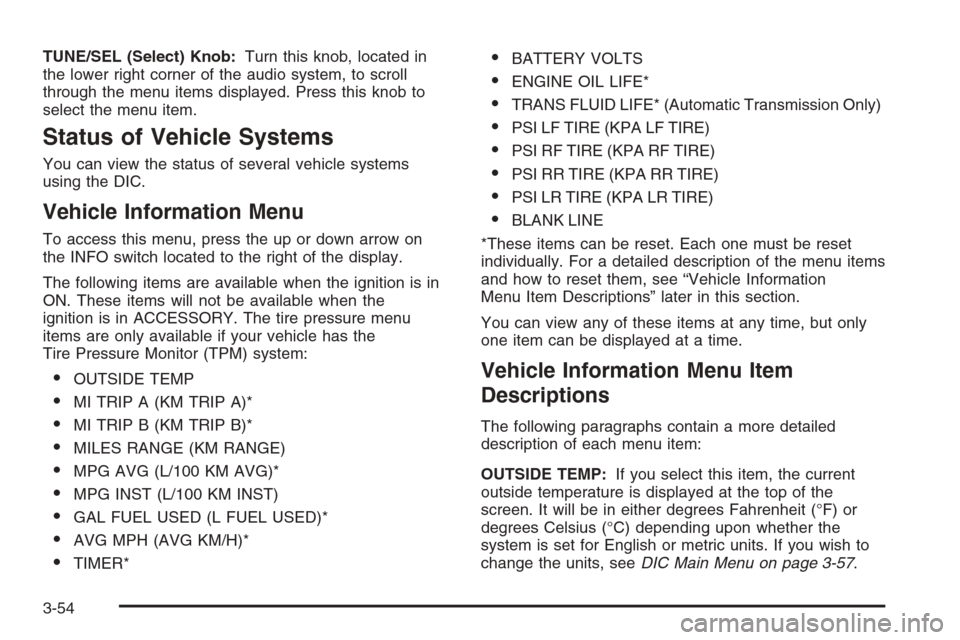
TUNE/SEL (Select) Knob:Turn this knob, located in
the lower right corner of the audio system, to scroll
through the menu items displayed. Press this knob to
select the menu item.
Status of Vehicle Systems
You can view the status of several vehicle systems
using the DIC.
Vehicle Information Menu
To access this menu, press the up or down arrow on
the INFO switch located to the right of the display.
The following items are available when the ignition is in
ON. These items will not be available when the
ignition is in ACCESSORY. The tire pressure menu
items are only available if your vehicle has the
Tire Pressure Monitor (TPM) system:
OUTSIDE TEMP
MI TRIP A (KM TRIP A)*
MI TRIP B (KM TRIP B)*
MILES RANGE (KM RANGE)
MPG AVG (L/100 KM AVG)*
MPG INST (L/100 KM INST)
GAL FUEL USED (L FUEL USED)*
AVG MPH (AVG KM/H)*
TIMER*
BATTERY VOLTS
ENGINE OIL LIFE*
TRANS FLUID LIFE* (Automatic Transmission Only)
PSI LF TIRE (KPA LF TIRE)
PSI RF TIRE (KPA RF TIRE)
PSI RR TIRE (KPA RR TIRE)
PSI LR TIRE (KPA LR TIRE)
BLANK LINE
*These items can be reset. Each one must be reset
individually. For a detailed description of the menu items
and how to reset them, see “Vehicle Information
Menu Item Descriptions” later in this section.
You can view any of these items at any time, but only
one item can be displayed at a time.
Vehicle Information Menu Item
Descriptions
The following paragraphs contain a more detailed
description of each menu item:
OUTSIDE TEMP:If you select this item, the current
outside temperature is displayed at the top of the
screen. It will be in either degrees Fahrenheit (°F) or
degrees Celsius (°C) depending upon whether the
system is set for English or metric units. If you wish to
change the units, seeDIC Main Menu on page 3-57.
3-54